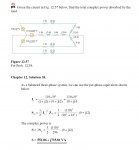Not much of a lesson. If you have a balanced resistive delta load the phase current will be in phase with the phase voltage. With a balanced resistive wye load the line current will be in phase with the line voltage. There is no way to tell the difference by any measurements on the three hot leads and the neutral.
What you cannot do is try to directly apply the angle between the line current and the phase voltage or vice versa.
Irrespective of whether it is delta or star connected balanced loads, the power factor angle to be used is the impedance angle ie the angle between phase voltage and phase current. That is the lesson in my last post.
It is really applicable for OP also.
View attachment 22390
Why don't I get the same answer using
P=3*V(phase)*I(phase)*cos(theta) or P= √3*V(line)*I(line)*cos(theta)
Since theta is always the angle between phase current and voltage, I used the angle of 46.75 degress





